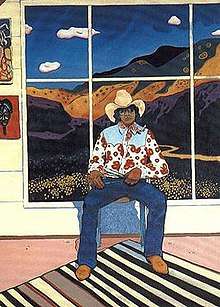T. C. Cannon
Tommy Wayne Cannon (September 27, 1946 – May 8, 1978) was an important Native American artist of the 20th century. An enrolled member of the Kiowa Tribe with Caddo and French descent,[1] he was popularly known as T. C. Cannon.
T. C. Cannon | |
|---|---|
 Self Portrait in the Studio, 1975, oil painting, 72 × 52 in., private collection | |
| Born | Tommy Wayne Cannon September 27, 1946 |
| Died | May 8, 1978 (aged 31) |
| Nationality | Kiowa Indian Tribe of Oklahoma (American) |
| Education | Institute of American Indian Arts; San Francisco Art Institute; Central State University |
| Known for | painting, printmaking |
| Movement | Native American art |
| Website | http://www.tccannon.com/ |
Early life
Cannon grew up in Zodaltone and Gracemont, Oklahoma. His parents were Walter Cannon (Kiowa) and Minnie Ahdunko Cannon (Caddo). His Kiowa name, Pai-doung-a-day, means "One Who Stands in the Sun."[2] He was exposed to the art of the Kiowa Six, a group of Native American painters who achieved international reputations in the fine art world and who helped developed the Southern Plains-style of painting. Stephen Mopope and Lee Tsatoke Sr. were particularly influential on the young artist.[3]
T. C. Cannon enrolled in the Institute of American Indian Arts of Santa Fe in 1964, where he studied under Fritz Scholder (Luiseño). After graduating from IAIA, he enrolled in the San Francisco Art Institute but left after two months and enlisted in the army.[4] As paratrooper in the 101st Airborne Division, Cannon was sent to Vietnam from 1967 to 1968. During the Tet Offensive, he earned two Bronze Star Medals. He was also inducted into the Black Leggings Society, the traditional Kiowa warriors' society.
Art career
While still stationed in Vietnam, Cannon had a breakthrough in his art career. Rosemary Ellison, curator of the Southern Plains Indian Museum in Anadarko, Oklahoma, included him in a major traveling exhibit, Contemporary Southern Plains Indian Art.
In 1972, Cannon and fellow artist Fritz Scholder had a two-man exhibition at the Smithsonian Institution's National Collection of Fine Arts, titled Two American Painters. In this exhibition, Cannon and Scholder subverted visual stereotypes about Native Americans, creating an exploration "in irony and kitsch" which "opened up a new phase of contemporary art".[5] Cannon produced a large body of work over the next six years, in preparation for his first one-man show, scheduled to open at the Aberbach Gallery in New York in October 1978. On May 8 of that year, however, he died in an automobile accident. After a delay, the show opened on December 10, 1979, as T.C. Cannon: A Memorial Exhibition. Featuring 50 works by Cannon, the show travelled to such locations as the Heard Museum, the New Mexico Museum of Art, and the Buffalo Bill Historical Center.
Commissions
Cannon painted murals at the United Indians of All Tribes Foundation and the Daybreak Star Cultural Center in Seattle, Washington, and the Santa Fe Opera Guild.[6]
Honors
Cannon was an artist-in-residence at Dartmouth College in Hanover, New Hampshire; Colorado State University in Fort Collins, Colorado; and the United States National Park Service. In 1988 he was inducted into the National Hall of Fame for Famous American Indians in Anadarko.[6]
Death
Tommy Wayne Cannon died in an automobile accident southeast of Santa Fe on May 8, 1978.[6]
Notes
- Frederick 8
- Frederick 12
- Frederick 16
- Frederick 37
- Berlo, Janet C.; Phillips, Ruth B. (1998). Native North American Art. Oxford: Oxford University Press. p. 225.
- Lester 95.
References
- Ellison, Rosemary (1969), "Contemporary Southern Plains Indian Art," Anadarko: Oklahoma Indian Arts and Crafts Cooperative.
- Frederick, Joan (1995), T. C. Cannon: He Stood in the Sun, Flagstaff, Arizona: Northland Publishing. ISBN 0-87358-603-4.
- Lester, Patrick D. (1995), The Biographical Directory of Native American Painters, Norman: University of Oklahoma Press. ISBN 0-8061-9936-9
- Wallo, William (1990), T. C. Cannon: Native American (A New View of the West). Oklahoma City: The National Cowboy Hall of Fame.
- Marshall, Ann E. (2017), Of God and Mortal Men: T.C. Cannon, Museum of New Mexico Press, Santa Fe, NM, (October, 2017), ISBN 0890136289
Further reading
- Bolen, Anne (Spring 2019). "An Art Revolution: T.C. Cannon Shows Native Life at The Edge Of America". National Museum of the American Indian. 20 (1). pp. 36–41.
- Benton, William (Autumn 1978). "T.C. Cannon: The Masked Dandy". American Indian Art Magazine. Vol. 3 no. 4. pp. 34–39.
- Kramer, Karen, ed. (2018). T.C. Cannon: At the Edge of America. Salem: Peabody Essex Museum. ISBN 978-0-87577-233-2.
- Gradwohl, David M. (1997). "Cemetery Symbols and Contexts of American Indian Identity: The Grave of Painter and Poet T.C. Cannon". Markers. XIV: vi–33.
- Rettig, David (Winter 1995). "T.C. Cannon". American Indian Art Magazine. Vol. 21 no. 1. pp. 56–57.
- Schjeldahl, Peter (April 15, 2019). "Ablaze: The early promise of T.C. Cannon". The Art World. The New Yorker. pp. 80–81. [Published online as "T.C. Cannon's Blazing Promise". The New Yorker. April 8, 2019.]
- Wallo, William; Pickard, John (September 1990). "T.C. Cannon". Southwest Art. Vol. 20 no. 4. pp. 68–76.